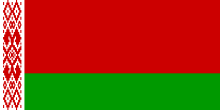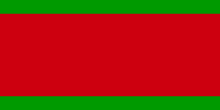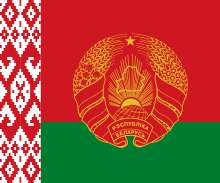Belarus flag
The flag of Belarus (Belarusian: Сцяг Беларусі, Stsiah Bielarusi; Russian: Флаг Беларуси, Flag Belarusi) was formally adopted on June 7, 1995 as a result of the referendum in which the Belarusian people participated during the previous month. This design replaced the flag used by the Belarusian People's Republic of 1918, before Belarus became a Soviet republic, and also used by the country after it regained its independence in 1991. The current banner is a modification of the 1951 flag used when the country was a republic of the Soviet Union.
Some groups have continued to use the red and white flag, despite its public display being restricted by the Belarusian government because of its association with Nazi collaborationism during World War II. This flag is displayed at anti-government demonstrations and is also used by certain Belarusian diaspora groups.
Design
This is the description of the national flag of Belarus according to the decree of June 7, 1995:
The national flag is a rectangular cloth consisting of two longitudinal stripes: a red top strip and a green bottom that occupy two thirds and a third of the width of the flag, respectively. A vertical design made of Belarusian red on white, which occupies a ninth of the length, is placed on the top. The ratio between width and length is 1:2. The flag is set on a golden-painted flag (ocre).
The flag hardly differs from that of the Byelorussian SSR: only the hammer and sickle and the red star are missing, and the red and white colors of the pattern on the pole area are reversed. The red on the flag represents the history of Belarus, as the color used by the country's forces in the Battle of Grunwald and the Red Army in its combat against Nazi Germany during World War II, and green represents the aspirations for the future and the multitude of forests present in the country.
In addition to the 1995 decree, the State Standardization Committee of the Republic of Belarus issued in 2008 the document "STB 911-2008: National flag of the Republic of Belarus" which provides the technical specifications of the national flag, such as details of colors and ornamental design. The latter occupies 1/12 of the length of the flag. Near the pole there is a thin red line that separates the flag from the sleeve used to fix the flag to the pole. The width of this line is 1/21 part of the white stripe that contains the ornamentation.
Colors
The colors of the national flag are regulated in the document "STB 911-2008: National Flag of the Republic of Belarus", issued by the State Committee for Standardization of the Republic of Belarus in 2008. Colors are named according to the CIE D65 colorimetric standard. Pantone's color identification system.
| Color | Coordinated color | And10 | |
|---|---|---|---|
| x10 | and10 | ||
| Red | 0.553 ± 0.010 | 0.318 ± 0.010 | 14.8 ± 1.0 |
| Green | 0.297 ± 0.010 | 0.481 ± 0.010 | 29.6 ± 1.0 |
| Pantone (non-official) | |||
| Album 2000 | 1795 C Red | 370 C Green | Sure. |
| Protocol Guide to the Beijing Olympic Games 2008 – Flag Manual | 032 Red | 355 Green | Sure. |
Decorative pattern
A decorative design, designed in 1917 by Matrena Markevich, is shown on the hanging portion of the flagpole (and previously on the 1951 flag). The pattern is of a traditional type commonly used in Belarus that is derived from local plants and flowers. These patterns are sometimes used on clothing, but can be seen primarily on the traditional rushnik, a traditional woven cloth worn at religious services, funerals, and other social functions. An example of its use could be a host offering his guests bread and salt served on a rushnik. On the current flag, the decoration symbolizes the cultural past and current unity of the country.
Protocol
By law, the Belarusian flag has to be flown daily – weather permitting – at the following locations:
- National Assembly of Belarus
- Council of Ministers of Belarus
- Courts of Belarus and offices of local executive and administrative bodies
- Buildings where meetings of councils of local deputies are held
- Military bases or military ships belonging to the government
- Buildings used by Belarusian diplomats
The flag of Belarus is also flown on the following occasions:
- Meetings of local executive and administrative bodies
- Voting places
- Stadiums and sports pavilions during competitions (even though the International Olympic Committee has its own rules on the flag protocol)
The flag is also displayed on vehicles used by Belarusian diplomats and various government officials, such as the president or prime minister.
The law allows the flag to be used on special occasions such as obsequies and festivities and can be used by various groups of people such as public organizations, businesses and non-governmental organizations. These guidelines were published in the same decree by which the Belarusian flag was created. May 15 was declared the Day of the Belarusian Coat of Arms and Flag (День Государственного герба и Государственного флага Республики Беларусь). Navies of the country. The ratio of width of the state flag with respect to the length of the mast must be a minimum of 1 to 3.
Historical flags
Soviet flag of 1951
The flag of the Byelorussian SSR was adopted by decree on December 25, 1951. It was slightly modified in 1956, specifying manufacturing details for the red star and the golden hammer and sickle. It had a length to width ratio of one to two (1:2), like the flag of the Soviet Union and those of the other fourteen ensigns of the republics of the Soviet Union. The main part was red, representing the October Revolution, and the rest was green, representing the Belarusian forests. A pattern of white on red decorated the left side and in the upper corner of the same side, over the red portion, the hammer and sickle were added in gold along with the silhouette of a red star above it. The hammer represented the worker and the sickle the farmer; according to Soviet ideology, these two symbols were intertwined, thus representing cooperation between the two classes. The red star, a very common symbol in communist parties, was said to represent the five social groups (workers, youth, peasants, military and academics), the five known continents or the five fingers of a worker's hand. Both the star and the hammer and sickle were sometimes not represented on the back of the flag. The final specifications were determined in article 120 of the Constitution of the Byelorussian SSR, and are quite similar to the current Belarusian flag.
Previous Soviet-era flags
Before 1951, and after the Revolution, several flags were used. The first of all was completely red and was in force in 1919 during the existence of the Lithuanian-Belarusian Soviet Socialist Republic. After the formation of the Byelorussian Soviet Socialist Republic, the initials ССРБ (SSRB) were added in gold in the upper left part of the flag; this design was established in the first constitution of the country. ensign was changed again in 1937, when the red star, hammer and sickle were added above the letters; in addition, the ratio of 1:2 was formally determined for the first time. This flag remained in use until the adoption of the 1951 flag.
The white-red-white flag
The design of the flag, used between 1991 and 1995, is believed to have been created by Klaudzi Duzh-Dusheuski before 1917 and for use by the Belarusian People's Republic (March to December 1918). This flag is known in Belarusian as Бел-чырвона-белы сьцяг (byel-chyrvona-byely s'tsyah, "white-red-white flag&# 3. 4;). In fact, red and white have been colors traditionally used in the heraldry of the Grand Duchy of Lithuania and that of the Polish-Lithuanian Confederation; the colors are based on those of the traditional coat of arms (Pahonia) of the Belarusian lands, with a white knight on a red background.
There are many other theories that explain the origin of the flag. One of them alludes to the name of the country (White Russia). Another – the traditional explanation – is that in 1410, when armed units from Poland and the Grand Duchy of Lithuania defeated the Germans of the Teutonic Order at the Battle of Grunwald, a badly wounded Belarusian tore off a bloody bandage and raised it as a banner. Victory; this story is similar to the traditional explanation of the origins of the Austrian and Latvian flags (both have the red-white-red color series).
During the Belarusian People's Republic (1918-1919) some variations of this flag were used. The white-red-white color is still used by the government in exile of the People's Republic. Between the years 1919 and 1925, the ensign remained with the same colors, although black stripes were added to the upper and lower part of the red sash.
Between 1921 and 1939, the white-red-white flag was used by the Belarusian national movement in Western Belarus (part of the Second Polish Republic), both by political organizations – such as the Belarusian Union of Peasants and Workers or the Democracy Belarusian Christian Church– and by apolitical organizations –such as the Belarusian School Society–. The flag was also used by the country's special battalion in the Republic of Lithuania army. Following the 1939 Soviet invasion of Poland, the flag was also banned in Western Belarus by the Soviet administration.
In 1941 the Nazi occupational administration allowed its use again; it appeared on the insignia of Belarusian Heer volunteers and the Waffen-SS and was used by the Belarusian Central Rada, the pro-German Belarusian government between 1943 and 1944. After the end of World War II, the flag was used by the Belarusian diaspora in the West and by small groups of anti-Soviet resistance in Belarus itself.
In the late 1980s the flag was used again as a symbol of romantic nationalism and democratic changes in the country. Following a proposal by the Belarusian Popular Front, the flag became the state symbol of independent Belarus since 1991.
Since 1995, the white-red-white flag has been used as a symbol of opposition to the Aleksandr Lukashenko regime, mainly in protests following the 2006 and 2010 presidential elections and in commemorative Freedom Day demonstrations and in the Dziady commemorative marches. The use of the flag in a public way is not prohibited but it is considered by the authorities an unregistered symbol, so its display by political activists or sports fans can lead to arrest and confiscation of the flags.
In early 2010, activist Siarhei Kavalenka was arrested for placing the flag on top of a Christmas tree in the central square of Vitebsk. The courts sentenced Kavalenka to a three-year suspended sentence (preventing recidivism), so that after Kavalenka was arrested again, he went on hunger strike for several weeks. It was interrupted by force-feeding on January 16, 2012.
The 1995 referendum
The referendum held to decide on the adoption of the national symbols took place on May 14, 1995. The adoption of the new flag was approved with a majority of three to one (75.1% against 24.9%) with a participation of 64.7%. The other three issues were also approved. The way in which the referendum was carried out and the legality of asking about the national symbols in it were highly criticized by the opposition. 48.6% of the electorate approved the new national emblem.
President Lukashenko had already tried to hold a similar referendum two years earlier, in 1993, but failed to get the necessary parliamentary support. Two months before the May 1995 referendum, Lukashenko proposed a design for the flag consisting of two small green stripes and a wider red stripe. Soon after, new designs appeared and were incorporated into the options present in the 1995 referendum ballot.
Other related flags
Since the flag's introduction in 1995, many other flags adopted by government agencies or bodies have been based on it.
The presidential banner, in use since 1997, was adopted by a decree called "Regarding the banner of the President of the Republic of Belarus". Its design is an exact copy of the national flag with the addition of the Belarusian shield in gold and red. Its ratio of 5:6 –almost square– differs from that of the national banner. It is used on buildings and vehicles to denote the presence of the president.
In 2001, Lukashenko issued a decree creating a flag for the Belarusian Armed Forces. The flag, with a ratio of 1:1.7, has the national ornamental pattern along the side of the flagpole. On the front is the Belarusian coat of arms, with the words УЗБРОЕНЫЯ СІЛЫ ("Armed Forces") arched above it, and РЭСПУБЛІКІ БЕЛАРУСЬ ("of the Republic of Belarus") written below. the text of both is in gold. On the reverse of the flag, the center contains the symbol of the armed forces (a red star surrounded by a wreath of oak and laurel). Above the shield is the motto ЗА НАШУ РАДЗІМУ ("For our homeland"), and below it the full name of the military unit.
Contenido relacionado
Lady from ibiza
Thera
Russian cinema











